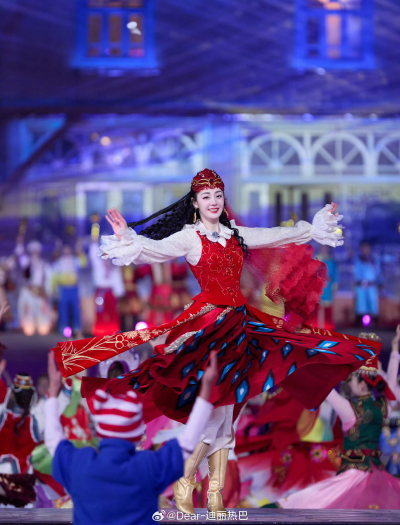| Xinjiang Today |
| Out of many, one | |
|
|
 Popular actress Dilraba Dilmurat wows audiences during the 2024 CCTV Spring Festival Gala, a major annual variety show broadcast on Chinese New Year's Eve, which fell on February 9 in 2024 (DILRABA’S WEIBO ACCOUNT)
From red lanterns at the International Grand Bazaar in its capital of Urumqi to horse races on the Narat Grassland in Ili, people in Xinjiang Uygur Autonomous Region celebrate the Spring Festival in diverse ways. As the most important traditional festival in China, the Spring Festival is enjoyed by all ethnic groups. China counts 56 ethnic groups. Besides the Han people, who make up some 91 percent of the population, 55 other ethnic groups, collectively known as ethnic minorities, call the country home. In Xinjiang, however, the Uygur, one of the ethnic minorities, has a larger population than the Han. According to the latest national population census, Xinjiang's population exceeded 25.8 million as of November 2020, with Uygur people totaling 11.6 million and Han people 10.9 million. The Spring Festival is a time for family reunion and New Year's celebrations, with rituals varying from region to region. In Xinjiang, apart from ubiquitous red decorations, ethnic dances and sports are also part of the celebrations, giving tourists a different experience. Red is an auspicious color because it is believed to be able to scare away the mythical beast preying on people at the turn of the year. In December 2024, the United Nations Educational, Scientific and Cultural Organization (UNESCO) inscribed the Spring Festival, or social practices of the Chinese people in celebration of traditional new year, on the Representative List of the Intangible Cultural Heritage of Humanity. According to UNESCO, intangible cultural heritage includes traditions inherited from ancestors, such as performing arts, social practices, rituals and festive events. The traditional Chinese calendar interprets time according to the cycles of both the moon and the sun. The lunisolar year is divided into 12 lunar months, or 13 in leap years. The Spring Festival falls on the first day of the first lunar month, or January 29 this year. The year beginning on this day is the Year of the Snake in the Chinese zodiac, a 12-year cycle of animal signs. The listing of the Spring Festival as intangible cultural heritage of humanity is an acknowledgment of not only its Chinese roots but also the values it embodies that connect humanity such as love, peace and harmony. Alongside the Spring Festival, Eid al-Adha (Festival of Sacrifice) and Eid al-Fitr (Festival of Breaking the Fast) are also public holidays in Xinjiang, with the former locally known as the Corban Festival and the latter as the Roza Festival. They are mainly celebrated by ethnic groups including the Uygur, Hui and Kazak. The coexistence of festivals with different origins is a testament to the region's ethnic diversity and social inclusion. |
|
||||||||||||||||||||||||||||
|